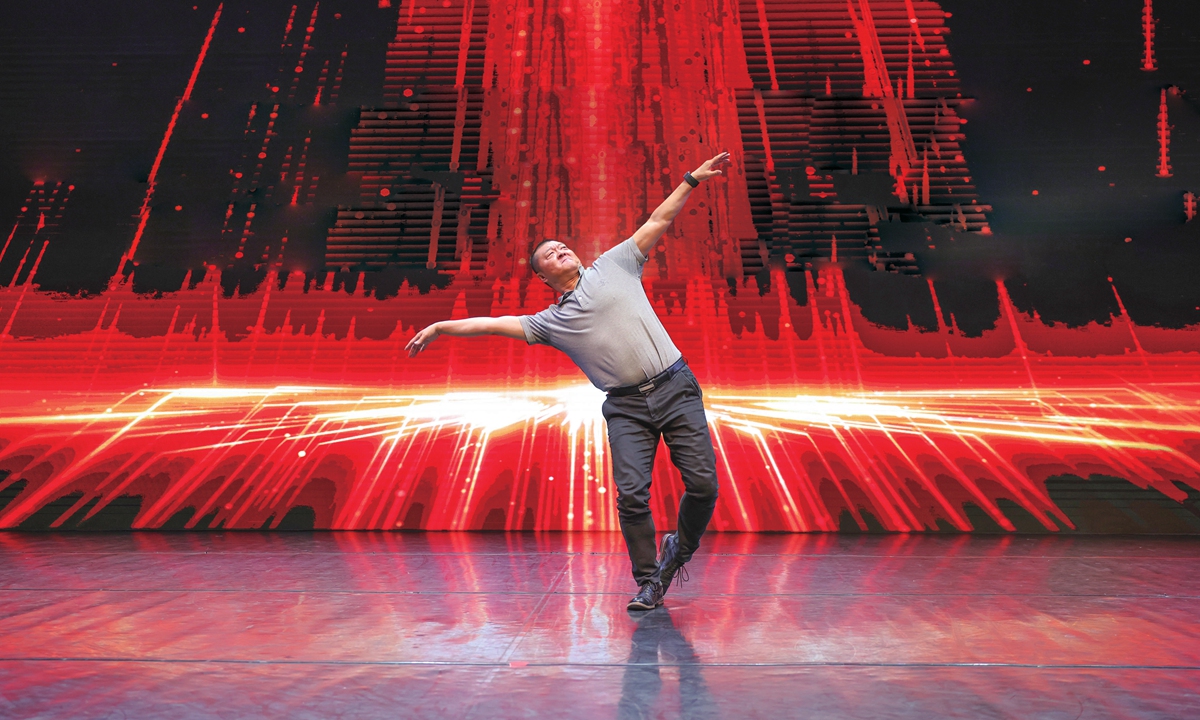
Jiang Tiehong performs the Mongolian folk dance Benteng. Photo: VCG
In the rehearsal hall of the Dance Academy at Minzu University of China (MUC), drum beats mingle with the melody of the
morin khuur, a traditional Mongolian bowed instrument.
Jiang Tiehong, a sturdy, silver-haired man, moves with focused precision among his students - leaping, stomping and fully embodying the spirit of the grasslands.
A 2024 video of Jiang casually dancing a Mongolian folk dance with his students went viral on social media, quickly amassing millions of views.
A grey polo shirt and black leather shoes framing a slightly fuller figure, Jiang's movements were powerful yet relaxed, his joints supple and fluid.
Jiang, 57, told the Global Times that the video's popularity highlighted something often overlooked in dance: the power of lived experience.
"Dance is not just about youthful appearance or physical perfection; it's about the depth of experience and the connection you build with the art over time," he said.
"That authenticity resonates with people beyond age or looks."
Passion in motionJiang shared the story behind the viral video with the Global Times. During a rehearsal for finale piece Benteng - literally "horse galloping" - at the academy, students urged him to join their dance despite his casual attire, which normally would not be permitted.
A colleague happened to capture this spontaneous moment and posted it on social media, where it quickly drew widespread attention and went viral.
The unexpected response, Jiang said, reinforced for him the need to keep ethnic dance alive through daily practice.
"Dance requires muscle memory. Anyone who dances should feel it every day; that's how it becomes part of you," he told the Global Times.
"Since I started learning dance, I've never stopped practicing. Whether as a student or a teacher, on stage or in the classroom, I've never slackened."
The video also attracted an avalanche of viewer comments on MUC's official account, with many expressing strong interest in seeing more dances from diverse ethnic groups.
As the dean of the Dance Academy of MUC, Jiang maintains a busy but fulfilling daily schedule.
He revealed that each year the academy stages several new ethnic dance works, and he not only guides students' rehearsals, but also actively dances alongside his students.
"We cover dances such as those of the Tibetan, Uygur, Korean, Yi, Miao and many other ethnic groups," Jiang said. "Whether it's a classic or a new creation, I dance with the students."
Beyond rehearsals, he often takes students on off-campus dance exchanges across the country.
"Going out, experiencing different cultures, and interacting with other dancers is vital for their growth," he said.
Jiang stresses that the inheritance of ethnic dance demands vitality and innovation.
He participates in every new work, from choreography to fine-tuning details, striving to balance respect for tradition with modern aesthetics so the dance can truly "speak" and reach wider audiences.
He prefers to call his students "friends," encouraging them to dare to try and feel deeply.
"I want them to not only learn steps, but to also tell stories and convey emotions with their bodies," he said.
"When a young 'bird's wings are not yet fully grown, all it can think of is flapping hard. Only when its strength has been honed to a certain point can it soar across the vast sky," he noted.
"That is a kind of freedom that comes after trials, and that's why it's so beautiful."
In Jiang's view, those who truly love to dance are, in essence, dancing out their own life experiences.
Lifetime BentengLooking back on his career, Jiang has spent decades moving between the stage and classroom, weaving his life into the contribution of dance.
Having enrolled in the MUC in 1989, his very first class was this iconic dance.
Years later, he became a fifth-generation lead dancer, bringing Benteng to the stage nationwide and winning countless accolades.
Over the past three decades, he has trained generations of dance talents, while also spearheading the Ministry of Education's top-tier dance education program.
Since beginning his teaching career, he has taught over 10 core undergraduate courses, including Mongolian Dance, Chinese Ethnic Dance and Ethnic Dance Pedagogy.
He has supervised more than 20 cohorts of undergraduate theses, guided students to win over 30 awards at national-level dance competitions, and led students to participate in more than 30 major national and provincial performances, according to the Beijing Dancers Association.
Under his guidance, the creative scope of ethnic dance has expanded - retaining the essence of traditions such as Mongolian and Dai dances, while incorporating modern stagecraft and cross-cultural elements.
"Tradition is the root, but innovation is the blossom," Jiang said. "When the two grow together, ethnic dance stays vibrant and relevant."
Jiang has created and performed dozens of works, including
Zange,
Bamboo Dance, and
Brave Heart, many of which have won awards at major competitions such as the China Dance Lotus Award.
He has also served as a judge for national dance contests and taken active roles in the China Ethnic Minorities Association and the Beijing Dancers Association, advancing ethnic dance in academic, performance, and societal arenas.
In 2016, Jiang lost 40 kilograms to prepare for his comeback performance of the challenging
Life is Flickering. In 2021, he once again led Benteng, continuing to convey the resilient spirit.
"Dance is not merely an art form; it is the living memory of a people, carried forward through generations," Jiang said.
